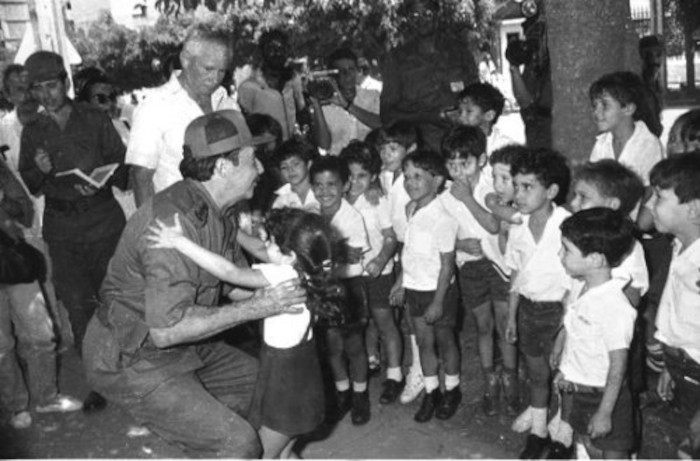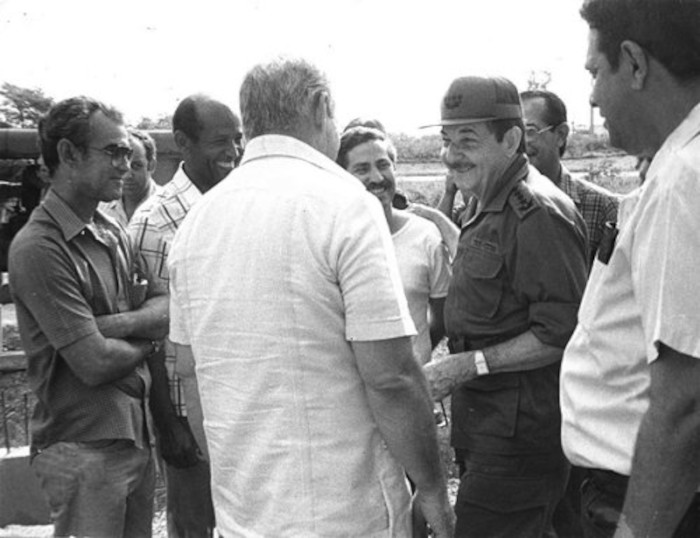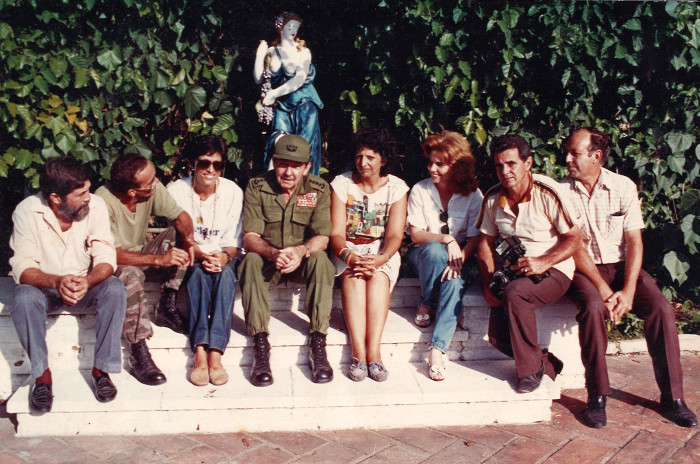CAMAGUEY.- “Journalists: you missed the report of the year!” Raúl exclaimed with the characteristic high-pitched voice, while colleagues from the national and provincial media who were waiting for him and his entourage at the house of officers and combatants of the Ministry of the Interior of Camagüey, were surprised by the expression.
He had gotten dark. With that gift of explaining and offering arguments to convince, he argued that in the Minaz Agroindustrial Construction and Assembly Company (Ecmai), near the Lenin district, he reasoned that not all Camagüey's citizens could accumulate 208 hours of volunteer work, a popular movement supported by a Special emulation to opt for the national headquarters of July 26, 1989.

In that work center, first visited on the afternoon of March 5, 1988, a companion worked, the mother of a child, who to participate in the voluntary days had to leave him with a neighbor. The father, a member of the Merchant Marine, most of the time was on the high seas, a more than justified reason for her being limited to that extra contribution. Therefore, the Army General insisted that voluntary work should have productive support, in accordance with individual possibilities, without diminishing the importance of family care, other tasks and the use of free time.
He was just beginning the tour of the area where he was shown a low-cost housing prototype built using the ferrocement technique, and he was heard saying: How there are women journalists! "No, no, we are architects and civil engineers," explained one of the professionals. She then noticed our absence, which she immediately noted and gave us the opening phrase.
Those of us who covered his visits to Camagüey and its municipalities are aware of the respect he professed for journalists and their attentions. For this reason, this is one of the many anecdotes jealously kept in memory to be reproduced as a fervent tribute to Raúl, who this June 3 celebrates 90 years of fruitful life in favor of the people.
AN ANECDOTIC ARSENAL
As far as is known, Raúl records 51 public visits to Camagüey, from June 22, 1959, the date on which he made an address to the people of Camagüey on the provincial radio, on the occasion of the application of the First Agrarian Reform Law, until the participation in the act of beatification of Father Olallo, held in the Plaza de la Libertad, a year and a half after the substantial speech of July 26, 2007 in the Plaza de la Revolución Mayor General Ignacio Agramonte.
Around Raúl, from 1959 onwards, defamatory campaigns were woven that branded him a despot and poor humanist sentiment; however, time was in charge of destroying the falsehoods and drawing the true and charismatic personality of him, easygoing, partying, rogue since he was little, and with a high sense of responsibility, demonstrated together with Fidel.
Who better than his older brother, Ramón, to narrate a little-known anecdote, during an interview conducted by this journalist in Camagüey, when he was an advisor to the Ministers of Sugar and Agriculture.
He said that in the bedroom of the La Salle Brothers religious school in Santiago de Cuba, where he and Fidel were studying, Raúl, very young, had the idea of placing a rope on one of the toes of a classmate and tie the other end to the bell tower. When the boy suddenly woke up, the bell shook the tranquility of the dawn.
Raúl always reserved space to relax the tensions of those who accompanied him. On January 31, 1994, the press team awaited him for his departure to the Oriente Rebelde Popular Council, in Sibanicú. He burst in with his typical olive green suit and the four stars of General of the Army. After good morning, addressing the journalists, he asked: "Did they saddle you like the General's horse?" A colleague responded. "We arrived a moment ago." He has always been of the opinion that there is no reason to waste people's time. "Having them waiting so long, indiscipline the troops," he said.
The idea of eliminating the "crossing" of milk to save fuel to which he referred on July 26, 2007 in our Plaza de la Revolución, we had perceived long ago, on August 8, 1990 during the visit to the dairy farm 4 -13 of the Najasa Livestock Company.
Since then he described as irrational to produce milk in one place, take it to a collection center and transfer it to Camagüey, at a great distance, to pasteurize and part of it to return to the area to be delivered to children and medical diets. After asking the First Secretary of the Party there for the quantities of liters received and the number of return to that rural area, he did not resist the temptation to comment: "Fidel and I took it directly from the cow's udder and look at us here." .
During 1988, Raúl visited Camagüey on four occasions. After the aforementioned stay at Ecmai, he attended the ceremony for the delivery of the Defense List Flag in the first stage of the province on March 6, and made a fruitful tour of Nuevitas the next day.
On June 12 of that year, he presided over the last stage of the 35th Anniversary Maneuver of the assault on the Moncada Barracks in the Ignacio Agramonte national park of the FAR, a few days after the water hit due to heavy rains that caused flooding in the city of Camagüey and serious damage to homes and loss of material resources.
The strategic exercise had begun in Guantánamo with the participation of troops from various provinces. Here he demonstrated his greatness and human sensitivity. Faced with the bewilderment of a plane crash, he took the floor and called for uniting wills in such a dramatic moment, with the purpose that the maneuver, which he said "will go down in the history of military art", would conclude as planned. At the ceremony, he expressed that he had a bitter duty to report the death of Eliazar Ordoñez Gamboa, a first class pilot, with more than 800 hours of flight, who died in the accident during the first episode of the last stage of the exercise.
It is impossible to summarize the intense days of visits, exchanges with industrial workers, mobilized for agricultural work by different institutions and unions, with combatants from the FAR and the EJT ...
The fact published by Adelante on February 29, 1992, in which it is narrated that Raúl's entourage, at the gesture of two women asking for a ride on the outskirts of the city, stopped the march and picked them up. One of them, a nurse and then head of the obstetrics ward of the Santa Cruz del Sur hospital, Aneida Acosta Alemán, said that she felt the greatest happiness of her life, because in part she fulfilled her childhood dream of meeting, first, Fidel and now Raúl.
On another occasion, in front of the 18-storey building under construction on the grounds of the Plaza de la Revolución, aided by the amplification and with a joyful tone, he asked the builders who were at the top of the building if Lázaro Vázquez, then first secretary of the Party in the province, shared with them. The answer was affirmative. Later, in the main street of the Garrido district, he exchanged with Minint fighters, with children from day care centers, and with workers from the Dr. Octavio de la Concepción y la Pedraja military hospital.
That expression of Raúl in a press conference at the end of three days in the province, collected in Adelante on August 9, 1990, comforts and should serve as an incentive for Camagüey's citizens: “Really when one finishes a tour of these, although with a little tired, he leaves with a rejuvenated soul, an oxygenated mind and ready to continue fighting ”.
No one should have doubts that Raúl, who professed respect and admiration for his brother Fidel, whom he described as a giant, is made of a special material tailored to the people to defend him against thick and thin in stormy currents, in the middle of the hostile and insane economic, financial and commercial blockade of the United States administrations.

The Army General, that Soldier of the Four Stars for the modesty that he reveals in every act of his life, from his new trench of duty and with his foot on the stirrup until the last breath of his life, will continue to radiate an example of faith in the Revolution and defense of the Homeland for the present generations that give continuity to the historical combatants.
- Translated by Linet Acuña Quilez




